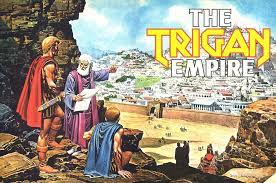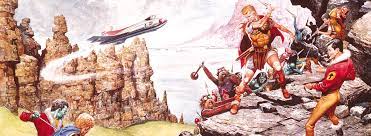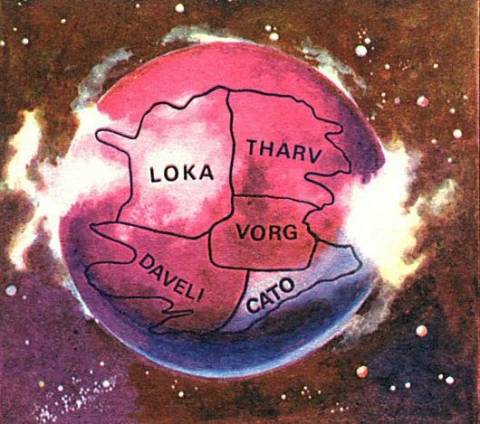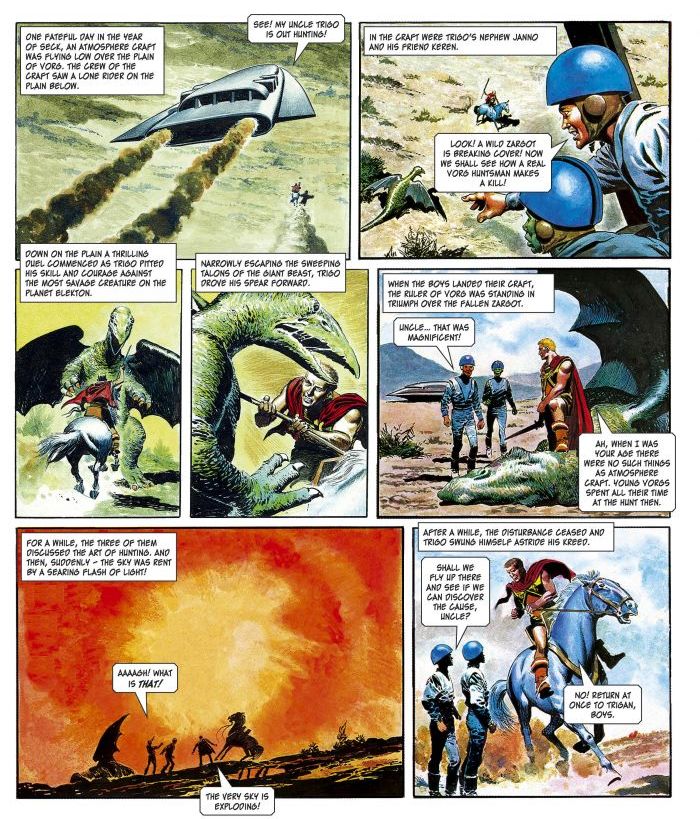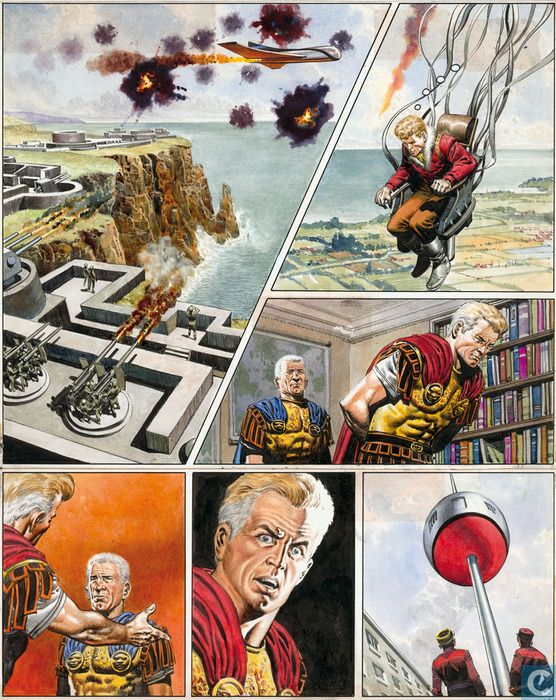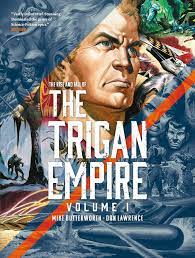The world of the Trigan Empire
After Dan Dare, The Trigan Empire is surely the most famous
mid-20th century SF comic strip for those of a
certain age (millennials). Alas, younger generations of
SF aficionados risk missing out. So, Jonathan Cowie revisits
the Empire as the classic is just being reprinted.
Quick links to sections below:-
Its place in Britain's SF scene of the 1960
The Trigan Empire premise
Trigan's creators
The Empire today
Its place in Britain's SF scene of the 1960s
SF buffs of a certain age – those who were children in the 1960s – saw science fiction develop beyond the classics of Wells and Verne and beyond pulp authors, into the new media of television and the post-war boom of comic strips: only a few authors (such as Wyndham) were considered by the general public as literary. But that did not matter. The sixties in Britain was the time of the 'white heat of technology' and SF was gaining a certain popular traction. For instance, on the then new medium of television (just two channels back then), we had things like Quatermass and Gerry Anderson was beginning to do his thing that a decade later would lead to Thunderbirds and UFO. On the author front, among others, we had Brian Aldiss, Ken Bulmer, John Brunner, Harry Harrison (well, he spent much of his life in Europe), Ted Tubb and, of course, one Arthur Clarke. Science fiction, back then, may have been in the ghetto, but it was most certainly on the ascendancy.
For kids of a very specific age, television's Gerry Anderson was godlike. His first TV series was for little more than toddlers but with each successive series he appealed to kids just a little older: a generation literally grew up with Gerry for over a decade and into their teenage years. I'll return to Gerry in another article as for now I would like to focus on that Technicolor comic strip that is The Trigan Empire.
|
|
If you were aged between, say, seven and fourteen in Britain in the 1960s then you would have almost undoubtedly come across Dan Dare ('pilot of the future') and then next, the epic-in-scope, The Trigan Empire. Both appeared in comics that had the official school teacher stamp of approval: Dan Dare appeared in the approved Eagle comic and The Trigan Empire in Ranger (whose other notable SFnal strip was Space Cadet). When its publisher, Fleetway, folded Ranger, The Trigan Empire moved to Fleetway's Look & Learn: again, both this and Eagle were school 'approved'. Both Dan Dare and The Trigan Empire had great, highly colourful, artwork: school kids couldn't miss them.
In one sense Dan Dare was almost pedestrian. I say 'almost pedestrian' not to be derogatory but because by the 1960s the idea of rockets and astronauts had already moved from science fiction into science fact…
|
 The Trigan Empire stands next to Eagle's Dan Dare (above) as the iconic SF strip of 1960s British comics.
The Trigan Empire stands next to Eagle's Dan Dare (above) as the iconic SF strip of 1960s British comics. |
|
Southeast Britain suffered from V2 rockets in World War II just a decade and a half earlier. Yuri Gagarin had already become the first cosmonaut and Alan Shepard an astronaut with John Glenn to be the first astronaut to orbit the Earth. Space in the early 1960s was in the news every season: even Clarke's seemingly SFnal vision of communications satellites was already on the drawing board! Dan Dare may have been the pilot of the future but space pilots already existed in the 1960s; it was The Trigan Empire that gave us: alien vistas, colourful armies, monsters, aliens, political intrigue, air battles, robots and even a space mission. There was a heck of a lot packed into the strip. What more could young SF enthusiasts want?
The Trigan Empire premise
So, what was it all about?
Well, imagine the ancient Mediterranean civilisations of Carthage, Greece and Rome in a world as diverse as our own with mountains, deserts, jungles and seas, and peopled with great and small civilisations as well as barbarians, with their histories, myths and legends, and not to mention a plethora of biomes and strange animals. And imagine the most advanced of these civilisation having jet fighters and hovercraft. This was the world of The Trigan Empire.
The epic begins with a Trigan spacecraft crashing on Earth: the only time humans and something from Trigan came in contact. Onboard were four dead, humanoid aliens about 12 feet tall. (This was the only time we learn of this size difference as everything on their world was to scale: there was no other reference to human dimensions.) Also onboard were writings. These were eventually translated. They, it transpired, were the history of the Trigan Empire and they became the stories recounted in the comic strip.
|
|
Billions of miles away as the star of Yarna (the strip's writer did not have a science background, hence the scale of light years, but did make up for it with vision and his artist colleague's interpretation). Circling it, as Earth circles the Sun, was the planet Elekton. It had eight continents with the biggest being Victris. Victris itself was divided into regions that included among others: Loka (which had an advanced civilisation bent on conquering the planet), Tharv (with its own advanced, but peace-loving civilisation – think of Athens) and Vorg (the home of simple, nomadic hunters).
|
|
|
|
Though content with their lives one of the Vorg, Trigo, could see that trouble was brewing and that Loka was bent on war with Tharv. After that Loka would possibly look to the lands of Vorg. Trigo had a vision to build a Vorg civilisation advanced enough to stand up to the Lokans. Alas his knowledge was too limited and his first attempt to build a city wall literally fell. However, when the Lokans decimated Tharv, learned Tharv refugees provided the skills the Vorgs lacked and together they built a fine city. Trigo now had the basis of what was to become an empire: the Trigan Empire.
The Tharvs also had the learning to provide the technology that gave the Trigans their own jet (atmosphere craft) air force. All this inevitably led to the Trigans being able to stand up to the Lokans. They were to the continent of Victris as Rome was to the civilisations of the ancient Mediterranean, Europe, the Middle East and North Africa. The Trigan history was as rich, and its stories, as varied as any that came out of classical times with battles, monsters, love, betrayal and political intrigue, all lubricated with bags of sense of wonder.
|
|
|
It has to be said that the strip was ostensibly written for eight to twelve year olds even if it was also enjoyed by slightly older kids: it did not have the sophistication of, say, 2000AD's Judge Dredd with its social and political satirical comment of the past couple of decades, hence have more adult appeal. The characters in The Trigan Empire were decidedly two-dimensional. Brag, Trigo's brother is devoted and well-meaning but slow-witted. Peric is an old wise man from Tharv, an architect and engineer, who helped establish the Trigan Empire, and transform the Vorgs from hunting nomads to an established and advanced civilisation. Janno, Brag's son and Trigo's nephew, is young, adventurous and an accomplished pilot. Keren (with olive green skin – yes, there was diversity) is Janno's best friend and son of Chief Imbala of Daveli whose culture closely mirrored that of Central American Indian civilisations. He becomes a pilot with Janno. Roffa is a homespun engineer from an agrarian culture who joins the Trigan air force. He is thin, angular and bespectacled (a clear attempt to provide, what at the time might be called, school swot readers a role model).
|
|
|
The plots too are similarly simple. War-mongering, betrayal, a new culture (which on one occasion included what passes for Medieval knights) or mythical creature encountered, political intrigue, or a misunderstanding that leads to conflict before becoming resolved. These might feature: plagues, drugged characters, time travel, alien encounters, hypnotic control, robots, youth serums and other SFnal and fantasy tropes.
The stories (almost mercifully for the adult reader) are short. However, a few follow an over-arching arc such as the initial stories featuring the Lokans who plan planetary domination. Another is a series of space adventures on one of Elekton's moons.
The plots and characters are not what the older SF aficionado turn to in The Trigan Empire: it is the mash of concepts and tropes, together with the artwork, that is the attraction.
Trigan's creators
The strip's creators were the writer Mike Butterworth and artist Don Lawrence (who was also a Guest of Honour at the 1989 British Eastercon in Jersey – a venue choice that caused some controversy due to a minority of vocal fans disagreeing with a democratic vote on, and its substantive win for, the venue… but that is another story).
|
|
Mike Butterworth originally trained as an artist but whose career was writing. However this training likely made him suited to scripting comic strips. He worked for Fleetway Publications both as a writer and an editor, which is how he got involved in writing the stories for The Trigan Empire. Following his time with Fleetway he became a full-time writer of crime (over a dozen books) and romance (ten) novels up until his passing in 1986. (One of his novels was published posthumously.)
Don Lawrence, trained as an artist but failed is finals. However he could draw and initially worked for Amalgamated Press that packaged comic strips. There he drew the superhero strip Marvelman and various Western comic strips. He then moved to Amalgamated Press that eventually became Fleetway Publications. His strips included Olac the Gladiator, Karl the Viking and Maroc the Mighty (incidentally, written by Michael Moorcock). In 1965 he was asked to draw The Trigan Empire which he did for eleven years.
|
|
|
|
Other artists were to follow but Don Lawerence determined the style and drew the strip for the longest: The Trigan Empire is most definitely associated with Lawrence.
Lawrence also drew other strips including Fireball XL5 for Gerry Anderson's TV Century 21. Though he complained bitterly about having to draw featureless wooden puppets. Fortunately, these have been reprinted in collections. Also, infamously (he kept it quiet), he drew the (literally) strip Carrie for the gentlemen's magazine Mayfair.
The Trigan Empire itself is drawn with black ink and coloured using water colours in a largely realistic style with some characteristic distortion. For example, villains often had narrow beady eyes and were rarely handsome: conversely, Emperor Trigo himself was an Adonis. The result for kids reading the strip was a visual feast.
The Empire today
In 1982 the last edition of Look & Learn (17th April) featured the final The Trigan Empire story written by Ken Roscoe and drawn by Gerry Wood. It has to be said that the artwork by the other artists was a little distinct from Don Lawrence's, but nonetheless it still was The Trigan Empire.
Since then there have been a number of graphic collections reprinting the original adventures. The collection for serious British SF comic strip fans to have is that which comprises the twelve volumes of luxury hardbacks reprinted by the Don Lawrence Collection between 2004 and 2008. This collection was based on the original artwork without omissions that, alas, were found in other reprints. For die-hard enthusiasts, this is the collection to get though it is very expensive.
For those with less deep pockets, and who only want a taste of Trigan, there were other collections. In 1978 Hamlyn Publishing in Britain, and Chartwell Publishing in the US, produced a hardback collection. Then in 1989 a hardback was printed by Hawk Publishing. This edition has some omissions (including some whole pages).
The film rights were optioned in 2009 and by 2011 there was even a script. Alas this languished in development hell.
In 2017 there were plans for a television series. The screen-stories for ten episodes were written and concept artwork drawn. These were loosely based on 'The Reign of Thara' (also known as the 'Battle for Trigan City') but with added twists. The series had even hired its own Roman Empire expert: one Dr Emma Southon.
Then in 2018 the rights to The Trigan Empire were acquired by Rebellion Developments and that put paid to the TV series. Rebellion is a successful computer games company run by brothers who are also comic fans. When in July 2000, the weekly 2000AD (notably, the home of Judge Dredd and The Strontium Dog) was about to be axed by IPC, Rebellion stepped in and saved the publication. It also took over producing graphic collections of past 2000AD strips. Their enthusiasm for British comics is such that in 2017 they acquired the copyright to Fleetway and IPC comics backlist. Also in 2017, they announced plans to develop a Judge Dredd television series. In 2018 they bought the Daily Mail's printworks building to convert it into film/television studios. This development is going to take a few years and then, once production starts, a few more years before we see the first series (and, of course, 2020 and 2021 has seen the SARS-CoV-2 / CoVID-19 lockdowns). What all this likely means for either a film or TV series of The Trigan Empire is that Rebellion are likely to want to do this themselves. However, given that Rebellion already plans to produce Judge Dredd and The Strontium Dog film/TV series, it is not likely that we will see a The Trigan Empire production at least for several years. Nonetheless, a series and/or film may eventually see the light of day.
|
|
Meanwhile, Rebellion are not simply sitting on The Trigan Empire, they are currently re-printing the adventures in graphic collections. So far, three of these The Rise and Fall of the Trigan Empire volumes are out all the first Butterworth/Lawrence strips:-
- vol. 1 (2020) ISBN 978-1-781-08755-8
- vol. 2 (2020) ISBN 978-1-781-08775-6
- vol. 3 (2021) ISBN 978-1-781-08932-3
(Right: Cover of the first volume in Rebellion's run of The Trigan Empire graphic reprint collections.)
Jonathan Cowie
|
|
|
|
